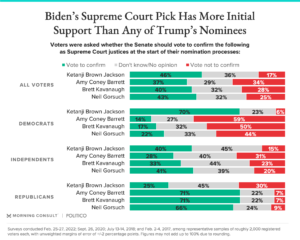In his article, “The Coming Republican Civil War Over Russia: The crucial debate goes on hold during the invasion of Ukraine, while Republican realists remain MIA” at The Nation, Jeet Heer shares his thoughts on Republican factions of the political moment:
In a Washington Post column, Amber Phillips provided a useful taxonomy of three primary types: the Hawks, the Putin Sympathizers, and the “Why Should We care?” Contingent. (For the sake of clarity, I’ve shifted the order of her listing.) To this list one could note there is a fourth ideological type that existed in the past but now is notably missing: the Republican Realists.
The Hawks are the most familiar of the four types. These are the unreconstructed Cold Warriors, the people who never trusted the Russkies and perhaps thought glasnost and perestroika were fake. Some of them still tend to refer to Russia as the Soviet Union. Mitt Romney is the emblematic figure here. The Hawks want a strict hard-line policy of containing and isolating Russia. They want NATO to act as the guard dog that makes sure Russia doesn’t dare cast a shadow outside its own borders.
The Putin Sympathizers are the traditionalist authoritarians who have come into prominence in the Trump era. They see Putin as a bulwark against global liberalism, someone who upholds gender norms and Christian values. Although often associated with Trump, this tradition can be seen earlier in Pat Buchanan.
The “Why Should We Care?” Contingent are the heirs of the older Robert Taft Republican isolationists. They insist that America needs to look after its domestic concerns first and foremost and avoid being drawn into foreign quarrels. Missouri Senator Josh Hawley gave voice to these sentiments by saying, “Sending new troops, expanding the security commitment and expanding NATO—I just think that’s a strategic mistake.” In terms of policy, this group aligns with the Putin Sympathizers.
The Republican Realists are the missing voices in the debate. These are national security types who prioritized advancing American business interests, which often meant making deals with hostile powers and finding a way to accommodate international differences. This is the tradition of James Baker and Brent Scowcroft. Unlike the Hawks, this group both understands and values diplomacy—especially when dealing with peer rivals like Russia and China. Unlike the Putin Sympathizers or the ”Why Should We Care?” Contingent, the Republican Realists were not unilateralists. They valued international agreements and building alliances.
If the current Ukraine crisis recedes, we’re likely to see a renewed debate among the Hawks, the Putin Sympathizers and the “Why Should We Care?” Contingent. Yet all of them offer unsatisfactory solutions. They are either too militaristic or too unilateralist. The disappearance of Republican Realists means that we’re not likely to get a shrewd and prudential Republican foreign policy alternative. Which is too bad, since in a two-party system that’s something that is desperately needed.
For Democratic midterm candidates, the challenge is to benefit from the deepening GOP divisions. Yes, Dems must do a better job of promoting the Biden Administration’s real accomplishments. But Democrats, not just candidates, should also unite in branding the Republican party as elitists focused on: providing ever-larger tax cuts for billionaires, expressing contempt for democracy and having a high tolerance for bigots who trash our county’s best values (see Sasha Abramsky’s “Putin’s Republican Sympathizers,” also in The Nation).
Hit hard and often. Leverage the magic of repetition. That’s what Republicans do.









